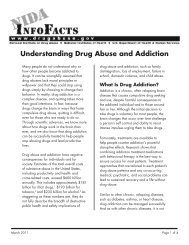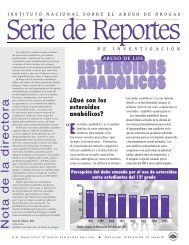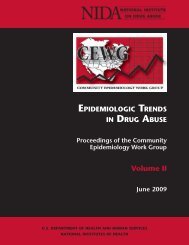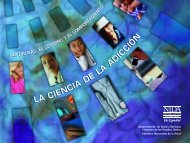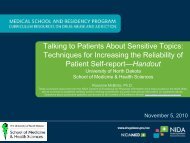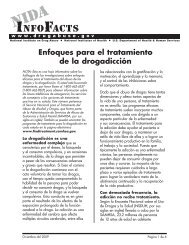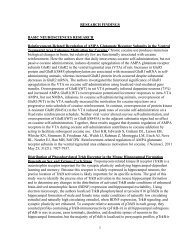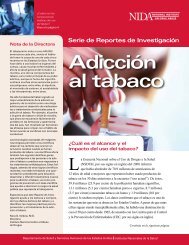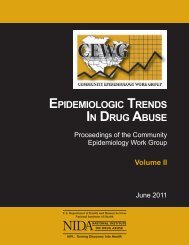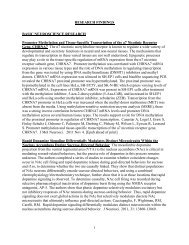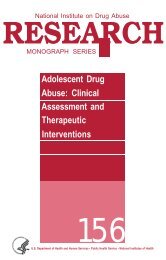CEWG January 09 Full Report - National Institute on Drug Abuse
CEWG January 09 Full Report - National Institute on Drug Abuse
CEWG January 09 Full Report - National Institute on Drug Abuse
Create successful ePaper yourself
Turn your PDF publications into a flip-book with our unique Google optimized e-Paper software.
EpidEmiologic TrEnds in drug AbusE: HigHligHTs And ExEcuTivE summAry<br />
as primary; this represents 4 percent of admissi<strong>on</strong>s,<br />
similar to the previous 2 years. <str<strong>on</strong>g>Full</str<strong>on</strong>g>y <strong>on</strong>ehalf<br />
of prescripti<strong>on</strong>-type opiate treatment admissi<strong>on</strong>s<br />
were age 18–29, compared with 23 percent<br />
for heroin. Heroin unweighted ED reports for all<br />
case types totaled 979, approximately <strong>on</strong>e-half the<br />
number of prescripti<strong>on</strong> opiate reports. Just 81<br />
pieces of evidence submitted by local law enforcement<br />
tested positive for heroin, compared with<br />
129 for prescripti<strong>on</strong>-type opiates. Treatment admissi<strong>on</strong>s<br />
for heroin totaled 795 for adults (13 percent)<br />
in the first half of 2008, similar to the level<br />
observed for the prior 2 years, but down from<br />
2004 and 2005 when capacity was expanded. As a<br />
proporti<strong>on</strong> of methad<strong>on</strong>e maintenance treatment<br />
admissi<strong>on</strong>s, heroin has been declining, and prescripti<strong>on</strong>-type<br />
opiates as primary have increased.<br />
Youth admissi<strong>on</strong>s for heroin c<strong>on</strong>tinued to be rare,<br />
less than 1 percent of youth admissi<strong>on</strong>s. The 23<br />
percent of heroin primary admissi<strong>on</strong>s age 18–29<br />
represented an increase compared with a decade<br />
ago. Cocaine is by far the most comm<strong>on</strong> sec<strong>on</strong>dary<br />
drug, with 52 percent reporting cocaine as<br />
sec<strong>on</strong>dary to their heroin use. For the year ending<br />
June 2008, the overall rate of heroin treatment admissi<strong>on</strong>s<br />
per 100,000 populati<strong>on</strong> in King County<br />
was 86, compared with 30 for prescripti<strong>on</strong>-type<br />
opiates. The rate was much higher in Seattle, at<br />
150 per 100,000, and much lower in the eastern<br />
regi<strong>on</strong> of the county, at 20 per 100,000. There were<br />
a total of 55 heroin/opiate deaths in the year ending<br />
June 2008, the fewest recorded in at least a decade.<br />
Three-quarters of heroin-involved overdoses<br />
involved another drug, with cocaine detected<br />
in almost <strong>on</strong>e-half of heroin drug-caused deaths.<br />
As with treatment admissi<strong>on</strong>s, heroin was c<strong>on</strong>centrated<br />
in Seattle. The annual rate of heroin-involved<br />
drug-caused deaths per 100,000 populati<strong>on</strong><br />
was 5.1, compared with 2.5 for the county as<br />
a whole. Marijuana unweighted ED reports totaled<br />
875, slightly lower than those for heroin.<br />
Cannabis was the sec<strong>on</strong>d most comm<strong>on</strong> drug<br />
identified in local law enforcement seizures, with<br />
448 cases. Any use of marijuana was reported by<br />
85 percent of youth and 44 percent of adults at<br />
entry to treatment although youth were much<br />
more likely to report it as a primary drug of abuse.<br />
These proporti<strong>on</strong>s have held steady for adults, but<br />
represent a decline for youth. Marijuana is grown<br />
in indoor grow houses throughout the Seattle<br />
area. MDMA and other hallucinogenic drug use<br />
c<strong>on</strong>tinued in the Seattle area. In the last year or so,<br />
BZP has emerged as an MDMA-like drug, often<br />
being sold in tablet form as MDMA. It is reported<br />
that both dealers and users may be unaware that<br />
the substance is BZP. While BZP has apparently<br />
been available at low levels in recent years, use has<br />
increased substantially and is seen throughout<br />
Washingt<strong>on</strong> State. In 2007 there were no drug<br />
items identified as c<strong>on</strong>taining BZP am<strong>on</strong>g law enforcement<br />
seizures in King County, compared<br />
with 29 in the first half of 2008; there was a single<br />
drug item identified as positive for BZP in neighboring<br />
Pierce County in 2007. At the same time,<br />
MDMA is reported to be somewhat less available.<br />
There were 51 drug items identified as positive for<br />
MDMA in the first half of 2008, compared with<br />
249 in all of 2007. There was <strong>on</strong>e drug overdose in<br />
the first half of 2008 involving MDMA, a level<br />
similar to that seen since the sec<strong>on</strong>d half of 1999.<br />
Lysergic acid diethylamide (LSD) was reportedly<br />
returning in popularity, and psychedelic mushrooms<br />
c<strong>on</strong>tinued to be used. There was <strong>on</strong>e piece<br />
of law enforcement evidence positive for LSD in<br />
2007 and five in the first half of 2008. For psilocin/<br />
psilocybin (i.e., psychedelic mushrooms), the<br />
numbers declined from 31 to 6 for the same periods.<br />
DAWN ED reports totaled 102 for MDMA,<br />
36 for LSD, and 44 for miscellaneous hallucinogens<br />
(note that most ED cases do not undergo<br />
toxicology testing, and drug type is usually based<br />
<strong>on</strong> self-report). Law enforcement reports that<br />
MDMA is c<strong>on</strong>tinuing to be manufactured in British<br />
Columbia, Canada.<br />
Data Sources: <strong>Drug</strong> traffcking data were<br />
obtained from the <strong>Drug</strong> Enforcement Administrati<strong>on</strong><br />
(DEA) Seattle Field Divisi<strong>on</strong> Quarterly<br />
Trends in the Traffc <str<strong>on</strong>g>Report</str<strong>on</strong>g>s, redacted versi<strong>on</strong>s<br />
for <str<strong>on</strong>g>January</str<strong>on</strong>g>–June 2008. <strong>Drug</strong> overdose data were<br />
obtained from the King County Medical Examiner,<br />
Public Health—Seattle & King County for the<br />
66<br />
Proceedings of the Community Epidemiology Work Group, <str<strong>on</strong>g>January</str<strong>on</strong>g> 20<str<strong>on</strong>g>09</str<strong>on</strong>g>



